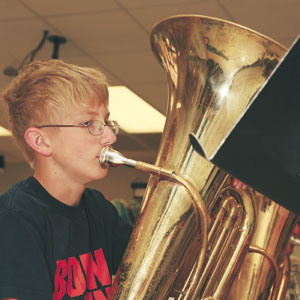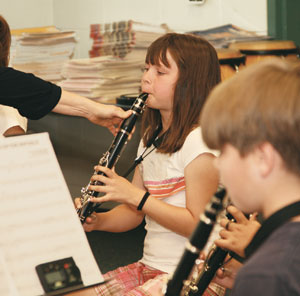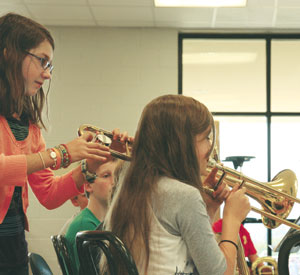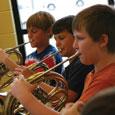 Editor’s Note: The October 2008 issue of The Instrumentalist included an interview with RoAnn Romines and George Hayden in which they shared information about their thriving band program. Here they offer specific details for teaching beginning students on woodwind, brass, and percussion instruments.
Editor’s Note: The October 2008 issue of The Instrumentalist included an interview with RoAnn Romines and George Hayden in which they shared information about their thriving band program. Here they offer specific details for teaching beginning students on woodwind, brass, and percussion instruments.
RoAnn Romines: The beginning of the school year is the most interesting to teach because it is fun and exciting for students, filled with new things to learn. In September we suggest directors set up rules or guidelines for their new students stating the goals they plan to accomplish over the next nine months. Each element of learning should eventually become a natural behavior.
Students quickly realize that these rules will help their individual learning. For example, when they enter the band room they know each one has a job for the day, whether it is tonguing correctly, having a good sound, setting up the area for a rehearsal, or tuning the band. Everyone contributes to how well the section or the entire ensemble does for that rehearsal. Ultimately, the personality, enthusiasm, and knowledge of a director are important to the growth of a music program and to each student.
George Hayden: September can be a difficult time for the many directors who teach beginning band because their new students are accustomed to elementary school classes taught in a comfortable atmosphere. Learning is quite different in typical band rehearsals where directors spend much of their time giving specific instructions for every part of the body.
The problem is introducing instruments in such a way that students learn to discipline their physical movements and at the same time expand their level of comfort to play at a high-quality level. The sequence and pace of skills have to progress so that first-year band students develop from the care-free world of elementary school to the discipline of learning musical skills they will need to perform for the next six or more years, perhaps into adulthood.
General Recommendations
RoAnn: Whenever possible band should begin in fourth or fifth grade with rehearsals held daily so playing and learning progress. George and I give students the choice of starting on one of five basic instruments – flute, clarinet, trumpet, trombone, or percussion – which prepares them for other instruments as early as sixth grade. Further, with a smaller curriculum, we can give more individual time to each section and teach more effectively.
As the students try the various instruments on the first day of class, we assess their abilities and guide their selection to the instrument on which they will do the best. Most students are flexible and eager to learn; their minds are like sponges, ready to soak up everything we say. Above all else, they want to learn and do well.
George: In the first year we expect students to acquire enough skill to play at a high level quickly. Instruction includes a rigorous but realistic curriculum focusing more on quality than quantity of material.
A Typical Rehearsal
RoAnn: Students have approximately ten minutes to warm-up the instrument correctly. Woodwinds check their reeds and their tonguing while flutes reestablish a warm dark sound with vibrato, check the pitches on crucial notes, and practice passages of works listed on the board.
The warm-up consists of scales, matching pitches within sections, matching pitches in different sections, chords, and chorales. Students reestablish the physical aspects of tongue placement, mouth placement, horn angles, hand positions, air stream, body posture, balance of instrumental sections, podium expectations, listening skills, and breathing. The warm-up defines your band program. It clearly sets the standards for the students and the director’s expectations for the program.
Clarinets, saxophones, double reeds, and low reeds may practice the full range of the chromatic scale to establish a good air stream and be sure the reed accommodates the high notes as well as the full range of the instrument. Next they check the tonguing on various octaves. This saves the director time during the rehearsal.
In terms of priority we want each student to do well on his instrument first, then do well in band second. This takes an encouraging approach instead of something that includes a lot of discipline. The method we use for each instrument, and for the band as a whole, takes the stress off students while rewarding their progress.
George: Our language and instructions are so specific that the students end up taking our words literally. When the fifth-grade flutes were practicing adjusting pitch and I mentioned raise the pitch, much to my surprise many raised the flute. An important part of our approach is giving students full knowledge of our rehearsal techniques and sequencing.
We believe band members should know what to expect at all times, whether it is which piece is next in a rehearsal or what we want to play for the next concert; this knowledge helps everyone to relax and concentrate on playing correctly. opinion most behavioral problems happen because students do not know what to expect or lack the information to fix a problem; they become frustrated or are surprised when a director is inconsistent in his approach.
 Practice, Without Music
Practice, Without Music
RoAnn: Fifth-grade students spend one week without music stands, which gives them a chance to concentrate on listening, matching pitches, and learning the physical elements of playing an instrument.
Every student has a tuner on the music stand, whether his own or from our class set; and we require some students to help the others in their section as they absorb new skills. Once we set up the music stands, class time is grouped into various sections:
1. Tuning, matching pitches, and holding a note.
2. Performing anything students wish for the class.
3. Slurring and tonguing patterns.
4. Working on an assignment from the book.
5. Learning a new technique or skill.
6. Reading the new assignment, which includes
a new technique, for the next class.
In between these sections, students practice and teach each other. This process continues throughout fifth grade and into sixth grade in sectionals.
George: Each fifth- and sixth-grade class begins when the first-chair clarinetist plays concert F, which prompts band members to stop warming up.
In addition to a tuner and music, each student’s stand has a pencil and color markers to jot down instructions. Students double check their posture, mouth placement, feet and hand position; and section leaders double check to be sure everyone is looking toward the podium and ready for the director’s down beat. The F concert pitch is held for several counts to several minutes.
The Details of Teaching Woodwinds
RoAnn: When school begins in August we start the step-by-step process of teaching new students. The fifth-grade woodwinds begin by holding one note, usually F concert; they sing the pitch and then hold it. They tune every day and match pitches every day.
We start clarinet students on the mouthpiece/barrel combination to establish correct mouth placement and sound. If we stay too long on this combination, students begin to use their throat to blow and drop the jaw too much; but for a few days it helps to establish the air stream, lower lip placement, jaw alignment, teeth placement, and lip pressure. We ask students to raise their upper lip and show their teeth resting on the mouthpiece and check the amount of mouthpiece in the mouth.
Once the clarinets learn to place the mouth firmly around the mouthpiece and play with a steady airstream, they hold the upper half of the clarinet with the right hand. At this point a strength 3 reed works well and helps them to quickly improve from holding one note to moving the fingers on C, D, E, F, G, A, and B flat. From the first lessons we daily check for correct hand position and finger movement because these two skills combined with a good embouchure are vitally important to overall playing.
Flute students spend at least two weeks learning to hold the flute correctly and playing either F or G with an embouchure that resembles pouting. While playing F, students have to hold the instrument correctly by locating the correct points of contact between the flute, the fingers, and the embouchure; for G, they drop the right hand while still maintaining a good tone and pitch. In August the objective for the flutes is to hold the instrument correctly and produce a continuous air stream. Without these criteria, producing good tone, pitch, and scale patterns at a reasonable tempo is impossible.
The class holds one note for a predetermined time. For example, clarinet students hold 16 counts in one breath while the flutes can take two breaths in the same period of time. Within the 16 counts students monitor the position of their mouth and the air stream; when playing they take note of the entrance of each note, their jaw and lip movement, and hand position. We ask them to listen for the pitch from a tuner and their partner’s pitch as well as how they release a note and whether they are tapping a foot.
As students play for longer durations, we have them monitor their breathing habits so they are ready to tongue continuously for one minute. Flutes use the syllable doo, always monitoring the skills they need to play well. In August flutes practice holding a note for 8-12 counts, which is considerably more difficult than on clarinet. Beginning clarinetists can quickly jump from 16 to 60 counts in just a few weeks, whereas developing air stream on a flute is more difficult and requires patience. We let students know this before they sign up.
George: We devote the month of August to teaching basic skills and building students’ confidence. Fifth-grade clarinetists usually quickly progress to adding the right hand and additional notes once they understand the physical elements of playing. Flute students can quickly add the right hand and play low C once they learn the physical elements of playing.
RoAnn: One element we never take for granted is the skill of holding still. It is mandatory and something students practice from the first day of fifth-grade band to the last concert of sixth grade. We even have the students practice holding still by staring at our face for three minutes without taking their eyes off our head. Imagine the image: no giggles for the first minute. Discipline of the body and the mind both contribute to achieving a good band, with humor and laughter as an important part of learning.
Reteaching Sixth-Grade Skills
George: We reteach basic skills to sixth-grade woodwind students when they return to school in August, including hand position, wrist angle, correct air stream, and the angle of the instrument. We check flute vibrato and review the correct way to sit on the edge of the chair with both feet flat on the floor. Students practice setting the mouth and tongue and breathing correctly; they release each note and tune to their partner. For tapping, we teach students to alternate both feet. The sixth-grade students work on scales, including the chromatic scale, chorales, and the eight major and eight minor scales.
During April and May of the fifth-grade year we observe prospective students to move to oboe, saxophone, or bassoon. The students try these instruments as we monitor their playing for several days, then decide who will make the change in mid-May before the last concert. They play the concert on their fifth-grade instrument and quickly begin lessons on the new instrument before the end of the month. Parents are involved in the process, and students have to agree to take lessons on the new instrument during the summer and through the sixth-grade year.
At the beginning of the year, we make sure the clarinets and saxophones have the correct reed for the mouthpiece. Clarinets should use a number 3 to 3½ reed because number 2 is too soft, making it difficult to produce a good air stream or correct lip pressure for both the high and low notes. Our saxophone section used a strength 3 reed but has recently changed to a V12 alto reed; low reeds also use strength 3 reed. Playing with weak reeds eventually teaches students to move the mouth, jaw, and air stream to accommodate the inferior reed. A reed that is too hard for the mouthpiece teaches students to blow from the throat, tongue the wrong way, and use incorrect air pressure.
RoAnn: High-quality bassoon and oboe reeds are crucial to having students play with good pitch and tone. While we like medium-hard reeds, directors should do their own research and be selective about the brand and quality. We begin every clarinet student on a number 3 reed with a 5RV mouthpiece. By December many students change to the 3½ reed. Only students in the advanced sixth-grade wind ensemble play strength 4 reeds because the mouthpieces are designed for harder reeds.
In September fifth-grade students continue with holding pitches, establishing good playing habits, and progressing to reading music. We pair up students, giving each one a partner to match pitches with during each class and team-teach each other throughout rehearsals. Remarkably, these partners seldom change and often last through high school.
George: The relationship between partners is an integral part of why the sections do so well. We watch to be sure their abilities match, so they have similar strong attributes as far as pitch, tone, and tonguing; they should also appreciate helping each other.
Expanding Students’ Ranges
RoAnn: After one month of study most fifth-grade clarinet students have added the notes played by the right hand to their growing list of skills, while many are becoming comfortable playing lower-octave notes with the pinky fingers. The flutes have accomplished playing a slow vibrato and low C, which introduces them to dark tones on the instrument; they are beginning to understand how the air stream affects the flute’s notes.
Once clarinet and flute students master the lowest notes on their instrument, we introduce the chromatic scale; from this point into the future, they begin every woodwind class warming up on a slurred chromatic scale. Flutes play their slurred chromatic scale up to high C7 and they learn to add vibrato.
We have clarinets slur the chromatic scale up to the high C6 by the end of September. This helps them establish the air stream necessary to play in different registers; and it teaches new players how the jaw, lip, and tongue move. It also sets the hand position for all the notes on the instrument and establishes the breathing necessary for a mature tone and mature pitch. Further, students are entirely happy about learning the chromatic scale because they get to play so many notes all within a few seconds.
George: In addition to the band book, we are now using fun books, such as Disney, Harry Potter, or hymn books as a reward when students reach our goals, and we help the fifth-grade students produce a consistent tonguing technique. By the end of September, clarinets and flutes should be able to tongue four 16th notes to a beat on one note at a tempo of 100.
Sixth-grade students should tongue four 16th notes to a beat at 120 or faster on one note and continue to learn scales. Clarinets learn the chromatic scale up to high G, and flutes continue to develop dexterity by playing scales. Saxophone students learn the chromatic scale up to high F6 and down to low B flat, depending on the size of their hands; double reeds maintain playing two-octave scales, and low reeds should be able to reach C above the staff.
Maturing Sixth-Grade Students
George: After a year of study the sixth-grade woodwinds begin developing a darker sound and a more solid pitch, especially if they sing scales and the melodies of their pieces, play using reeds that are compatible with the mouthpiece, and learn the concepts of blending and balancing with other instruments.
They are also ready to learn about alternate fingerings, ear training, faster tonguing techniques, and the tendencies of their instrument. By this time a woodwind player should be evaluating his reeds on a daily basis and changing them, if necessary. The importance of reeds cannot be overlooked because the sound of a good woodwind section depends on the quality of reeds, the mouthpiece/reed combination, and the stability of the reeds.
A band piece that has the clarinets using fast tonguing will be difficult if the reeds are too old and the reed tip too weak. At one performance our first-chair, sixth-grade clarinetist was performing under hot lights and stress. Unknown to us, her reed suddenly warped and stopped working. With an important solo as part of the concert, she had the foresight to take several extra reeds on stage. She timed switching the reeds perfectly and played beautifully, never portraying any sense of stress to the audience. Her knowledge of the instrument helped her through the performance. We were so proud of her.
Solo Playing
RoAnn: By October fifth-grade students have adjusted to playing alone in front of the class every day. While these solos help us to spot and remedy playing problem, they give students a reason to feel good about their abilities. Through solo playing students learn how to evaluate and fix their own playing problems as well as their partner’s. Further, it helps us to quickly identify the students who are playing by ear, mimicking a neighbor, or pretending to read the notation when they don’t understand it.
We believe students should feel comfortable if they make a mistake, because it is only through mistakes that directors can teach correct playing. That being said, playing alone should always be rewarded with praise and understanding, regardless of the performance. Directors have to watch how students hold the instrument and play, check for reading weaknesses, eyesight problems, a poor understanding of notation, and breathing difficulties, such as asthma, mouth breathing, and allergies.
Some students suffer from poor self-esteem, the result of emotional stress that may need attention, dental difficulties, and poor dexterity in the fingers or fingers that are too small. Inappropriate back-pressure, headaches, blowing from sinuses, or using the throat to tongue are just a few of the difficulties that may also produce playing problems.
George: In October, November, and December, the fifth and sixth grades focus on developing tone, reading comprehension, and improving their knowledge of notes and rhythms. Tonguing rhythms and scales, maintaining a pitch and good tone quality for a longer period of time, and concentrating for longer periods will improve.
By sixth grade, students have a better understanding of constructive criticism, show leadership abilities, and learn the faults and discrepancies of their instrument. Maintaining an instrument, tuning tendencies, the skill of how to practice, and ear training are other areas to develop in your students, all with a sense of humor and the goal to inspire them to love good music.
Holiday Music and Duets
RoAnn: Band books, Christmas tunes, and duets always motivate learning. By December the fifth-grade clarinets should be playing duets that involve tonguing notes above throat tone Bb. Flutes should be playing duets, trios, and quartets with notes up to high C and the fifth-grade woodwinds will have mastered the F concert scale and the Bb concert scale. Our sixth-grade students have hopefully mastered six scales.
The Christmas concert is only a means to use fun music to meet playing goals. Ensembles and students flourish the more they perform, so we encourage them to play regularly for nursing homes and churches on their own time.
With January comes with the goal of endurance: endurance of embouchure, breathing, and concentration as well as the endurance necessary to maintain pitch and tone at longer time intervals for both grades; sixth-grade students should be able to play for at least 45 minutes. We want fifth-grade students to add the remaining A, C, and E scales, while sixth graders pursue a total of eight scales. In the winter months we work on the ensemble skills of balance, blend, and matching pitches with other instruments. Students tune listening to chords for the first time and play rhythms on F and Bb concert.
George: Basic fifth-grade skills that build a foundation for good musicianship continue in spring semester; they are so important that RoAnn has her university clarinet students review them whenever they have difficulty with a passage.
When a professional musician practices four measures for one hour, it is not the notes but the fundamental elements of producing good sound, exact pitch, and clean entrances and releases in addition to a well-supported air stream that produce exceptional performances. The same holds true for fifth- and sixth- grade bands.
The fifth-grade clarinets continue to polish the chromatic scale with high G6 being the goal, but some will only be able to reach high C6. While the flutes and clarinets begin work on thirds in the band book, we give etudes, movie song sheets, and holiday tunes to various sections of the band, helping students to improve reading, tonguing, and range.
Sixth-grade woodwinds begin applying rhythms to scale patterns, tonguing patterns to scale patterns, and reading new music. Students memorize scales, thirds, and arpeggios as well as simple tunes; and we continue to give music to individual students to help increase their learning.
End-Of-Year Skills
RoAnn: February, March, April, and May bring about the compilation of many skills. Because we teach the instrument and not the pieces in a book, students have the ability to play any number of selections in the band book and in any order. In February we add compositions that are grade levels 1 and 2 in difficulty. By May the sixth-grade woodwinds have been introduced to 16th-note scales; rhythms with whole, half, and dotted-half notes, eighth- and dotted-eighth notes, and 16th notes; and 24, 34, 44 , and 68 meters.
George: In the first nine months of lessons they studied articulation, musical terms, pitch tendencies, instrument maintenance, breathing, tonguing, mouth and tongue placements, and solo playing. Tone production, tuning characteristics, ear-training, reading patterns, and reed knowledge will also be part of their newly acquired knowledge.
RoAnn: Several of the students have developed leadership qualities through music because they learned to set daily objectives and teach in teams where praise and rewards are important to learning.
Editor’s Note: In the October issue RoAnn Romines and George Hayden will describe how they teach fifth- and sixth-grade students on brass and percussion instruments.
News from LudwigMasters
Joseph Galison is the new director of sales for LudwigMasters Publications, a division of Kalmus; he is the fourth generation of the Kalmus family to direct its music publishing companies. LudwigMasters publishes music for concert band, orchestra and string orchestra, chamber ensembles, and solo instruments, and no products, even obscure classic works, are ever discontinued or dropped from its catalog. (efkalmus@aol.com or 800-434-6340)





